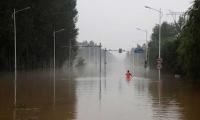The writer is an analyst and
commentator.
Of all the statistics that tell us a story about Pakistan, perhaps one of the least discussed but most important is Pakistan’s exports. Too often, we examine the export receipts at budget time, to assess how poorly (or well) the country has fared in increasing its earnings of foreign exchange.
This is an important thing to try to assess, of course. Higher dollar denominated receipts for Pakistan create a cushion of foreign exchange reserves, and help expand the Pakistani brand wider and deeper around the world. But exports tell us much, much more about ourselves – and it is clear that neither elected officials, nor our military and intelligence community, have thought very carefully at all about the story of our exports.
It doesn’t require a high level of training in economics to ascertain the importance of attempting to even out a country’s balance of payments. The more a country exports, and the less it imports, the greater flexibility it would tend to have. Yet this simplistic understanding of exports ignores the flip side of the coin. The more a country exports, the more connected, tied-in and dependent it becomes on that barter of goods and/or services for cash. This doesn’t mean exports aren’t a great way to grow the economy, or to seek improved balance of payments. It just means that the lens of trade requires an appreciation of the fact that whether a country has high exports, or high imports, or both, makes that country deeply connected to, tied-in with and dependent on other countries. Key takeaway? Other countries matter.
These basic facts about trade are important because in recent years, Pakistan’s civil and military leadership have both emphasised a number of buzzwords that, if genuine and sincere, make our collective Pakistani future look very bright. What are these buzzwords?
Corridor. Specifically, the China-Pakistan Economic Corridor (CPEC).
Region. Specifically, the fact that Pakistan straddles four distinct, broad economic regions: namely, South Asia, Central Asia, China, and Middle East and North Africa (or MENA).
Connectivity. Specifically, that Pakistan can serve as a connector of various regions to each other, and that there are large rents to be accrued to the Pakistani people, from the unique geo-political and eco-strategic location of Pakistan. Perhaps no single economic effort has ever received the kind of positive reinforcement from both civilian and military leaders in Pakistan, as has the CPEC initiative. Whilst this is largely seen as a bilateral arrangement between China and Pakistan, the corridor offers a range of benefits to a wide array of actors, including Afghanistan.
These benefits are on offer largely because of the unique position of Pakistan, as a periphery to a number of distinct regions, as well as a direct neighbour to three unique and increasingly important 21st century powers – China, India and Iran.
Finally, Pakistan is and will remain, one of the cheapest, most convenient, and most accessible gateways to both Afghanistan, and Central Asia.
Both national security hawks and doves agree, for different reasons, that achieving peace and stability are crucial to Pakistan’s ambitions for its people. And few better examples of this exist than the importance of peace and stability for Pakistan acting as an infrastructure hub for the various regions that it straddles and seeks to become a vital part of. However, the entire purpose of seeking this peace and stability is to grow the economy, to create jobs, and to proliferate prosperity at the individual, family, firm and institutional level. If the rhetoric of CPEC, regional connectivity, infrastructure, and stability does not create an economic impact, the rhetoric will be seen to be as shallow, hollow and meaningless as so many other slogans and jingles that we have sullied over the last seven decades.
Let us examine Pakistan’s exports performance in the last three years. The State Bank of Pakistan’s latest exports data shows that total exports of goods and services in FY13 was $31.53 billion. This fell to $30.42 billion in FY14, which then fell to $29.97 billion in FY15. In the last three years, the total exports of goods and services has fallen by over a billion and a half dollars. This is not a small drop.
The Economic Survey of Pakistan 2015-2016, which is published by the finance ministry each year at budget time confirms these numbers emphatically. The comparison between the first three quarters of FY15 and FY16 shows Pakistan’s exports falling by $2.3 billion, from $17.9 billion to $15.6 billion. This is a steep decline.
Let us completely ignore the anomalous fall in exports, in an era of falling imports (due to declining commodity prices). Let us instead look at the constitution of our exports themselves. Whom do we send our goods and services to?
Pakistan’s single largest exports destination is the US, to whom we sent 16.1 percent of all our exports in FY15. The share of our exports that we send to the US increased in FY15, up from 15.9 percent in FY14. The second largest exports destination is China, to whom we sent 9.4 percent of our exports. This was a decline, from 10.8 percent in FY14. The next seven countries to whom we sell our goods and services, in order are: Afghanistan, UK, UAE, Germany, Spain, Italy and Bangladesh.
Let us now consider the quality of our relationship with the countries to whom we sell our goods and services. The most pertinent recent commentary by a senior Pakistani official about the US was Sartaj Aziz’s press conference last week. With Pakistan’s relations with the US being the topic, Sartaj Sahib spent the entire presser discussing a drone attack in Balochistan, Narendra Modi’s tour of Washington DC, Pakistan’s plea for equal treatment for the Nuclear Suppliers Group, and the vindication of Pakistan’s position on the Pathankot terror attack.
These are the issues Pakistan’s leading foreign policy mind chooses to discuss in his own press conference (a time for him to help shape the tone), when detailing the bilateral relationship with the country to whom Pakistan sends the highest share of its exports.
The decline in China’s share of Pakistan’s exports, in the CPEC era is a real head-scratcher, but the most curious of all is the rising share of Afghanistan in our exports, at a time when the Afghans are deeply bitter about Pakistan’s purported failure to help President Ghani bring the Afghan Taliban and Haqqani Network to the negotiating table.
Pakistan’s response to frequent Afghan outbursts is to start squeezing Afghan refugees – mostly poor, helpless Muslims who sought sanctuary in the same country we proudly call the Fortress of Islam. Meanwhile, Afghan appeals for improved transit conditions for Afghan goods and services through Pakistan’s two critical pathways (through Karachi, by sea, and through Lahore-Wagah, by road) are constantly ignored by the Twin Towers of Ishaq Dar and GHQ. It merits some reflection that while we don’t have any clue as to how to use the opportunities trade can create for Pakistani influence in Afghanistan, we do not hesitate to squeeze refugees to express our displeasure.
How should we put together all this information? Let us summarise. One, Pakistan is all about the CPEC, regional connectivity and trade. Two, Pakistan’s overall exports are falling. Three, Pakistan’s share of exports to the US and Afghanistan are rising. Four, Pakistan’s share of exports to China is falling. Finally, five, Pakistan’s relationship with the US and Afghanistan are deteriorating fast – because of national security issues. So, how should we put together all this information?
Pakistan is suffering from extreme policy incoherence. Our words and actions do not match. Our priorities are conflicted and unclear. Our civil-military divide is real, and cannot be papered over. We have no Afghanistan policy to speak of – this the most important country in the world, for Pakistan. We can continue tossing out acronyms like CPEC, CASA-1000, TAPI and IP, but they are incongruent with how we speak about and engage with our key trade partners.
Bottom-line? Pakistan’s hunger, its economic ambition and its rhetoric are at cross-purposes with our national discourse. Countries in which Mumtaz Qadri can be celebrated, in which Afghan refugees can be demonised, and in which drone attacks are used as tools of diplomacy by a global superpower, do not become regional economic hubs. At a minimum, our civilian and military leaders should stop insulting our intelligence.
People in Gaza reported destruction of displacement camps as well as air strikes. — AFP/FileI have rarely felt so...
People throng at the Bohri Bazaar in Saddar, Karachi. — AFP/FileMounting concern over declining birth rates, the...
Pakistani youth wait for their turn for a Capital Development Authority job entry test in Islamabad. —...
Indian Prime Minister Narendra Modi spoke on the World Youth Skills Day on July 12, 2023. — AFP/FileThe recent...
Stranded people wade through a flooded area after heavy monsoon rainfall in Rajanpur district of Punjab province on...
A women sits at a laptop, head in hand, battling stress or fatigue in a dimly lit workspace.— Geo.tv/FilesThe...







